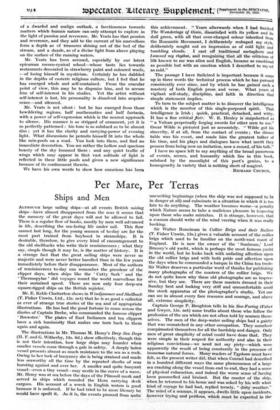Per Mare Per Terras
Ships and Men
ALTHOUGH large sailing ships—at all events British sailing ships—have almost disappeared from the seas it seems that the memory of the great days will • not be allowed to fail. There is a regular flow of books, mostly by men well advanced in life, describing the sea-faring life under sail. This flow cannot last long, for the young seamen of to-day are for the most part trained from boyhood in steamships. It is desirable, therefore, to give every kind of encouragement to the old shellbacks who write their reminiscences ; what they say, simple though it may be, is the matter of history. It is a strange fact that the great sailing ships were never so majestic and were never better handled than in the few years immediately before their disappearance. Most of the authors of reminiscences to-day can remember the grandeur of the clipper days, when ships like the Cutty Sark ' and the '
Thermopylae' did voyages round the world marvellous for their sustained speed. There are now only four deep-sea square-rigged ships on the British register. - - Mr. E. Keble Chatterton shows in Windjammer and Shellback (T. Fisher Unwin, Ltd., 15s. net) that he is as good a collector as ever of strange true stories of the sea and of appropriate illustrations. He has had the good fortune to come across the diaries of Captain Beebe, who commanded the famous clipper ' Brewster.' The plates of East Indiamen and tea clippers have a rich luminosity that makes one turn back to them again and again.
The illustrations in Mr. Thomas M. Hemy's Deep Sea Days (H. F. and G. Witherby, 12s. 6d.) show effectively, though this is not their intention, how large ships may founder _when smaller vessels come through a gale in safety. A deeply laden vessel presents almost as much resistance to the sea as a rock. Owing to her lack of buoyancy she is being strained and made less seaworthy all the time by the repeated shocks of seas bursting against and over her. A smaller and quite buoyant vessel—even a tiny vessel—may nestle in the curve of a wave. Mr. Hemy was at sea before the days of the Plimsoll mark and served in ships which rounded the Horn carrying deck cargoes. His account of a wreck in English waters is good because it is unforced. If he had tried to be more literary he would have spoilt it. As it is, the events proceed from quite unexciting beginnings (when the ship was not supposed to be in danger at all) and culminate in a situation in which it is too late to do anything. The weather becomes worse—a penalty which Nature seems to take a malicious pleasure in imposing upon those who make mistakes. It is strange, however, that a seaman should write of the wind veering when it was really backing.
Sir Walter Runciman in Collier Brigs and their Sailors (T. Fisher Unwin, 15s.) gives a 'valuable account of the collier brigs _which used to be familiar on the north=east Coast of ' England. He is now the owner of the ' Sunbeam,' Lord Brasse- y's old yacht, which is perhaps the most famous yacht in the world, but he looks back with unfading affection upon the old collier brigs and with both pride and affection upon the days when he commanded a barque in the China tea trade- Sir Walter deserves a particular word of thaiiks for publishing many photographs of the masters of the collier brigs. We do not quite know why these old photographs are so impres- sive, but they are. There are these masters dressed in their Sunday best and looking very stiff and uncomfortable amid the stock apparatus of the phOtographer's studio. Yet one can see in almost every face resource and courage, and above all, extreme simplicity. - Captain George P. Boughton tells in his Sea-Faring (Faber and Gwyer, 15s. net) some truths about those who follow the profession of the sea which are not often told by seamen them- selves. The men of the deep-water sailing ships had a gaiety that was unmatched in any other occupation. They somehow compensated themselves for all the hardship and danger. Only men of great simplicity of mind could have done that. They were simple in their respect for authority and also in their religious convictions—we need not say piety—which were apparently the result of being constantly in the presence of immense natural forces. Many readers of Typhoon must-have felt, as the present writer did, that when Conrad had described in a hundred different ways the same phenomenon of a large sea crashing along the vessel from end to end, they had a sense of physical exhaustion, and indeed the worse sense of having been pommelled and br-u ised. But themaster of the ship, when he returned to his home and was asked by his wife what kind of voyage he had had, replied tersely, " dirty weather." The mind of a seaman, it appears, dwells little upon incidents, however trying and perilous, with must be expected in the nature of his calling. St. Paul, not being a sail/1r; was evidently absorbed hi the efforts' made to save the ship in Which he was wrecked ; but if the truth were known it would probably be found that the sailors themselves soon forgot all that and remembered only the Viper which fastened upon St. Paul's hand after the landing. The merit of Captain Boughton's book is that in depicting typical scenes of sea-life he haS re- called emotions that have fleeted from the minds of most men with similar experience.































































 Previous page
Previous page